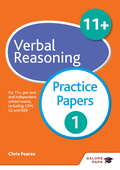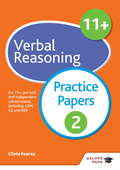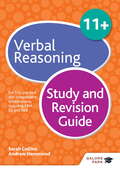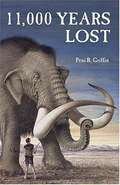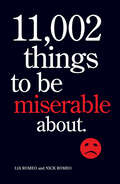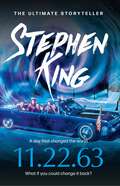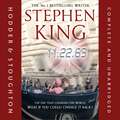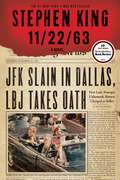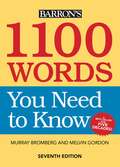- Table View
- List View
11+ Science Practice Papers: For 11+, pre-test and independent school exams including CEM, GL and ISEB
by Jackie Barns-GrahamPrepare for the most challenging of pre-tests and 11+ independent school entrance exams with five levelled exam papers designed to test pupils' ability across all Science topics for a better chance at getting into their school of choice.- Develops and perfects exam technique for all major pre-test and 11+ independent school exams including ISEB- Features levelled papers to help build skills for the top marks - Teaches pupils to improve their response rates with timed papers- Builds exam-room confidence by practising with a variety of exam paper styles- Identifies weaker areas and improves results with detailed answers and commentary- Prepares pupils for what they will face on exam day with a mock testAlso available for 11+ Science preparation: - 11+ Science Revision Guide ISBN 9781471849237Revision Guides, Workbooks and Practice Papers are also available for Maths, English, Verbal Reasoning and Non-Verbal Reasoning on www.galorepark.co.uk
11+ Science Practice Papers: For 11+, pre-test and independent school exams including CEM, GL and ISEB
by Jackie Barns-GrahamExam Board: ISEBLevel: 11 PlusSubject: ScienceFirst Teaching: September 2015First Exam: Autumn 2018Prepare for the most challenging of pre-tests and 11 plus independent school entrance exams with five levelled exam papers designed to test pupils' ability across all Science topics for a better chance at getting into their school of choice.- Develops and perfects exam technique for all major pre-test and 11 plus independent school exams including ISEB- Features levelled papers to help build skills for the top marks - Teaches pupils to improve their response rates with timed papers- Builds exam-room confidence by practising with a variety of exam paper styles- Identifies weaker areas and improves results with detailed answers and commentary- Prepares pupils for what they will face on exam day with a mock testAlso available for 11 Plus Science preparation: - 11 Plus Science Revision Guide ISBN 9781471849237Revision Guides, Workbooks and Practice Papers are also available for Maths, English, Verbal Reasoning and Non-Verbal Reasoning on www.galorepark.co.uk
11+ Science Revision Guide: For 11+, pre-test and independent school exams including CEM, GL and ISEB
by Sue HunterSecure the top marks in 11+ independent school entrance exams and pre-tests and a better chance at getting into their school of choice with this essential revision guide. Complete coverage of the ISEB 11+ Science syllabus and stretching extra content ensures that every topic is thoroughly revised ahead of the exams.- This book covers everything required for the 11+ Science exam- Prepares pupils for a wide range of independent school exams and pre-tests with challenging extension material- Consolidates revision with all the key information in one place- Features helpful insight in to the exams, with examples, practical tips and advice- Tests understanding and technique with timed, levelled exam-style questionsAlso available for 11+ Science preparation: - 11+ Science Practice Papers ISBN 9781471849282Revision Guides, Workbooks and Practice Papers are also available for English, Maths, Verbal Reasoning and Non-Verbal Reasoning on www.galorepark.co.uk.
11+ Science Revision Guide: For 11+, pre-test and independent school exams including CEM, GL and ISEB
by Sue HunterExam Board: ISEBLevel: 11 PlusSubject: ScienceFirst Teaching: September 2015First Exam: Autumn 2018Secure the top marks in 11 plus independent school entrance exams and pre-tests and a better chance at getting into their school of choice with this essential revision guide. Complete coverage of the ISEB 11 Plus Science syllabus and stretching extra content ensures that every topic is thoroughly revised ahead of the exams.- This book covers everything required for the 11 Plus Science exam- Prepares pupils for a wide range of independent school exams and pre-tests with challenging extension material- Consolidates revision with all the key information in one place- Features helpful insight in to the exams, with examples, practical tips and advice- Tests understanding and technique with timed, levelled exam-style questionsAlso available for 11 Plus Science preparation: - 11 Plus Science Practice Papers ISBN 9781471849282Revision Guides, Workbooks and Practice Papers are also available for English, Maths, Verbal Reasoning and Non-Verbal Reasoning on www.galorepark.co.uk.
11+ Verbal Reasoning Practice Papers 1: For 11+, pre-test and independent school exams including CEM, GL and ISEB
by Chris PearseExam Board: ISEBLevel: 11 PlusSubject: Verbal ReasoningFirst Teaching: September 2016First Exam: Spring 2017Practice exam papers to prepare children for the most challenging pre-tests and 11 plus independent school entrance exams. Practice Papers 1 includes ten levelled exam papers that will test pupils' skills in verbal reasoning for a better chance of getting into the school of choice.- Develops exam techniques tested in all major pre-tests and 11 plus independent school examinations including CEM, GL and ISEB- Features papers written to measured levels of difficulty to build ability- Teaches pupils to improve their response rates with timed papers- Builds exam-room confidence with practice in a variety of exam styles- Identifies weaker areas and improved results with detailed answers and commentary- Timed papers 1-4 build familiarisation of test conditions- Questions 5-8 are designed to increased speed, which is good practice for pre-test and CEM 11 plus- Questions 9-1- are long-style tests - perfect practice for GLThe brand new for 2016 11 plus and pre-test range has been constructed to help pupils follow a three step revision journey ..Step 1) 11 Plus Verbal Reasoning Study and Revision GuideStep 2) Practice Papers11 Plus Verbal Reasoning Practice Papers 111 Plus Verbal Reasoning Practice Papers 2Step 3) Workbooks11 Plus Verbal Reasoning Workbook Age 8-10 11 Plus Verbal Reasoning Workbook Age 9-11 11 Plus Verbal Reasoning Workbook Age 10-12
11+ Verbal Reasoning Practice Papers 1: For 11+, pre-test and independent school exams including CEM, GL and ISEB
by Chris PearseExam Board: ISEBLevel: 11 PlusSubject: Verbal ReasoningFirst Teaching: September 2016First Exam: Spring 2017Practice exam papers to prepare children for the most challenging pre-tests and 11 plus independent school entrance exams. Practice Papers 1 includes ten levelled exam papers that will test pupils' skills in verbal reasoning for a better chance of getting into the school of choice.- Develops exam techniques tested in all major pre-tests and 11 plus independent school examinations including CEM, GL and ISEB- Features papers written to measured levels of difficulty to build ability- Teaches pupils to improve their response rates with timed papers- Builds exam-room confidence with practice in a variety of exam styles- Identifies weaker areas and improved results with detailed answers and commentary- Timed papers 1-4 build familiarisation of test conditions- Questions 5-8 are designed to increased speed, which is good practice for pre-test and CEM 11 plus- Questions 9-1- are long-style tests - perfect practice for GLThe brand new for 2016 11 plus and pre-test range has been constructed to help pupils follow a three step revision journey ..Step 1) 11 Plus Verbal Reasoning Study and Revision GuideStep 2) Practice Papers11 Plus Verbal Reasoning Practice Papers 111 Plus Verbal Reasoning Practice Papers 2Step 3) Workbooks11 Plus Verbal Reasoning Workbook Age 8-10 11 Plus Verbal Reasoning Workbook Age 9-11 11 Plus Verbal Reasoning Workbook Age 10-12
11+ Verbal Reasoning Practice Papers 2: For 11+, pre-test and independent school exams including CEM, GL and ISEB
by Chris PearseExam Board: ISEBLevel: 11 PlusSubject: Verbal ReasoningFirst Teaching: September 2016First Exam: Spring 2017Practice exam papers to prepare children for the most challenging pre-tests and 11 plus independent school entrance exams. Practice Papers 2 includes eight levelled exam papers that will test pupils' skills in verbal reasoning for a better chance of getting into the school of choice.- Develops exam techniques tested in all major pre-tests and 11 plus independent school examinations including CEM, GL and ISEB- Features papers written to measured levels of difficulty to build ability- Teaches pupils to improve their response rates with timed papers- Builds exam-room confidence with practice in a variety of exam styles- Identifies weaker areas and improved results with detailed answers and commentary- Varied in length tests build in difficulty The brand new for 2016 11 plus and pre-test range has been constructed to help pupils follow a three step revision journey ..Step 1) 11 Plus Verbal Reasoning Study and Revision GuideStep 2) Practice Papers11 Plus Verbal Reasoning Practice Papers 111 Plus Verbal Reasoning Practice Papers 2Step 3) Workbooks11 Plus Verbal Reasoning Workbook Age 8-10 11 Plus Verbal Reasoning Workbook Age 9-11 11 Plus Verbal Reasoning Workbook Age 10-12
11+ Verbal Reasoning Practice Papers: For 11+, pre-test and independent school exams including CEM, GL and ISEB
by Chris PearsePrepare for the most challenging of pre-tests and 11+ independent school entrance exams with 10 levelled exam papers designed to test pupils' skills in Verbal Reasoning exams for a better chance of getting into the school of choice.- Develops and perfects exam technique for all major pre-test and 11+ independent school exams including CEM, GL and ISEB - Features papers written to measured levels of difficulty to help build skills to achieve the top marks - Teaches pupils to improve their response rates with timed papers- Builds exam-room confidence by practising with a variety of exam paper styles- Identifies weaker areas and improves results with detailed answers and commentary- Papers 1-4 build familiarisation of test conditions- Papers 5-8 are designed to increase speed to help with pre-tests and CEM 11+ exams- Papers 9 and 10 are long-style questions, which is perfect practice for GL examsAlso available for 11+ Verbal Reasoning preparation: - 11+ Verbal Reasoning Study and Revision Guide ISBN 9781471849244- Verbal Reasoning Workbook Age 8-10 ISBN 9781471849312- Verbal Reasoning Workbook Age 9-11 ISBN 9781471849329- Verbal Reasoning Workbook Age 10-12 ISBN 9781471849336Revision Guides, Workbooks and Practice Papers are also available for Maths, English, Science and Non-Verbal Reasoning on www.galorepark.co.uk.
11+ Verbal Reasoning Study and Revision Guide: For 11+, pre-test and independent school exams including CEM, GL and ISEB
by Andrew HammondSecure top marks in pre-tests and 11+ independent school entrance exams for a better chance of getting into the school of choice with this essential study and revision guide. Stretching content ensures that all the Verbal Reasoning skills are thoroughly revised ahead of the exams.- Explains and tests the most extensive range of question types and skills met in exams- Prepares pupils for a wide range of pre-tests and independent school exams with challenging extension material- Features helpful insight in to the exams, with examples, practical tips and expert advice - Prepares pupils for exam conditions with realistic timings and progressively stretching exam-style questions - Identifies strengths and weaknesses using a Summary Test with detailed answer guidance- Clear links between Verbal Reasoning and existing study of English- Includes topics such as constructing words, understanding word meaning, working with numbers and algebra, and developing logic skillsAlso available for 11+ Verbal Reasoning preparation: - Verbal Reasoning Workbook Age 8-10 ISBN 9781471849312- Verbal Reasoning Workbook Age 9-11 ISBN 9781471849329- Verbal Reasoning Workbook Age 10-12 ISBN 9781471849336- 11+ Verbal Reasoning Practice Papers ISBN 9781471849299Revision Guides, Workbooks and Practice Papers are also available for Maths, English, Science and Non-Verbal Reasoning on www.galorepark.co.uk.
11+ Verbal Reasoning Study and Revision Guide: For 11+, pre-test and independent school exams including CEM, GL and ISEB
by Andrew Hammond Sarah CollinsExam Board: ISEBLevel: 11 PlusSubject: Verbal ReasoningFirst Teaching: September 2016First Exam: Spring 2017An essential study and revision guide to help children secure top marks in pre-tests and 11 plus independent school entrance examinations. The stretching content ensure that verbal reasoning skills are thoroughly reviewed ahead of the exams.- Prepares pupils for all major pre-tests and 11 plus independent school examinations including CEM, GL and ISEB- Explains and tests all of the question types that pupils could face- Features helpful insight into the exams, with practical tips and advice- Identifies strengths and weaknesses using 11 plus sample tests with detailed answer guidance- Clear links between Verbal Reasoning and existing study of English- Includes topics such as constructing words, understanding word meaning, working with numbers and algebra, and developing logic skillsThe brand new for 2016 11 plus and pre-test range has been constructed to help pupils follow a three step revision journey ..Step 1) 11 Plus Verbal Reasoning Study and Revision GuideStep 2) Practice Papers11 Plus Verbal Reasoning Practice Papers 111 Plus Verbal Reasoning Practice Papers 2Step 3) Workbooks11 Plus Verbal Reasoning Workbook Age 8-10 11 Plus Verbal Reasoning Workbook Age 9-11 11 Plus Verbal Reasoning Workbook Age 10-12
11,000 Drinks: 27 Years' Worth of Cocktails
by Paul KnorrThe bible of booze is bigger and better than ever! This truly enormous compendium contains more than 30 years&’ worth of recipes, covering absolutely everything: from flaming shots and frozen drinks to martinis and tiki drinks. (There&’s even a chapter of X-rated cocktails for your naughty side!) Plus, you&’ll find plenty of helpful information on essential bartending tools and techniques, suggestions for stocking your home bar, and a glossary of ingredients to turn you into an instant mixologist.
11,000 Years Lost
by Peni R. GriffinWhat does it mean if you die before you were born? An eleven-year-old Texan girl finds out what it was like to live in the Ice Age in this action-packed time-travel adventure. As Esther participates in an archaeological dig in Texas, she is accidentally transported back in time. Living among the Clovis, the mammoth hunters, she learns of a very different childhood in which play is practice for survival and humans are prey for megafauna, scimitar cats, giant bears, and others. Will she ever get back to her own time? Peni R. Griffin has delivered her greatest time-travel story yet, a thrill-a-page adventure that's also an affecting look at family and what makes a home. Kids will be riveted by this richly imagined vision of prehistoric North America from a writer whose work has been called expertly plotted (Kirkus Reviews) and fascinating (Booklist). Discoveries of early American artifacts, clues to this little-known time, appear in the news frequently. The detailed bibliography in this book invites young readers to read and, like Esther, make discoveries of their own.
11,002 Things to Be Miserable About: The Satirical Not-so-happy Book
by Lia Romeo Nick RomeoSome people have 14,000 Things to Be Happy About. You’re not one of them. 11,002 Things to Be Miserable About is a list of all the reasons NOT to wake up in the morning. Ironically enough, when you put all of them under one cover, it’s actually very funny. This decidedly absurd inventory of misery is perfect for sardonic and disaffected youth, for people seeking gifts for Traumatic Event Birthdays (like 21, 25, 30, 40, and, well, anything after 40), and for anyone else with an offbeat sense of humor. Enjoy. Some of the entries are pretty basic, like imitation crabmeat, student loans, and David Hasselhoff, but other entries actually include educational things, like dust mites, which make up one-third of the weight of a six-year-old pillow. See, you can laugh and learn.
11,4 Light Dreams
by Nicholas AvedonIn the Paris of the 23rd century where everything is for sale, pure emotions are of great value to those who cannot live them. Ariel de Santos is a creator of Vivid Dreams, one of the few artists capable of shaping emotions to seduce and inspire a world that has forgotten to dream. This is the story of Ariel de Santos, one of the most renowned living artists of the Southern European States, a man tormented by his pacts with the devil and addicted to Trank, the universal drug. Through his eyes, we will witness an escape from the past in the most ambitious human endeavor in history, a journey without return to a destination in the stars.
11-B: The Noisy Neighbor
by David Connor E. F. MulderWarwick, whose name has a second W that’s silent, also has a new neighbor who is anything but. The constant creak of bedsprings and headboard banging against the common wall has Warwick in 11-A wondering if the activity in 11-B is an occupation and not merely an enjoyable hobby.When Warwick finally meets noisy neighbor Dom, though fun, heat, and music ensue, uncertainty and questions remain. Some things are easily explained away by the sort of happenstance and misunderstanding silly sitcom plots are based on, but a painful past connection, a difficult future, and a lie in the present set up roadblocks Warwick and Dom struggle to get over.Can Warwick and Dom create a second verse to their love song, or will the tune end before it really begins?
11.22.63
by Stephen KingKing's highly acclaimed novel, now with a stunning new cover look. WHAT IF you could go back in time and change the course of history? WHAT IF the watershed moment you could change was the JFK assassination? 11.22.63, the date that Kennedy was shot - unless . . . King takes his protagonist Jake Epping, a high school English teacher from Lisbon Falls, Maine, 2011, on a fascinating journey back to 1958 - from a world of mobile phones and iPods to a new world of Elvis and JFK, of Plymouth Fury cars and Lindy Hopping, of a troubled loner named Lee Harvey Oswald and a beautiful high school librarian named Sadie Dunhill, who becomes the love of Jake's life - a life that transgresses all the normal rules of time. With extraordinary imaginative power, King weaves the social, political and popular culture of his baby-boom American generation into a devastating exercise in escalating suspense.
11.22.63: Enhanced Edition
by Stephen KingWHAT IF you could go back in time and change the course of history? WHAT IF the watershed moment you could change was the JFK assassination? 11/22/63, the date that Kennedy was shot - unless . . . King takes his protagonist Jake Epping, a high school English teacher from Lisbon Falls, Maine, 2011, on a fascinating journey back to 1958 - from a world of mobile phones and iPods to a new world of Elvis and JFK, of Plymouth Fury cars and Lindy Hopping, of a troubled loner named Lee Harvey Oswald and a beautiful high school librarian named Sadie Dunhill, who becomes the love of Jake's life - a life that transgresses all the normal rules of time.With extraordinary imaginative power, King weaves the social, political and popular culture of his baby-boom American generation into a devastating exercise in escalating suspense.(P)2011 Simon & Schuster Audio
11/22/63: A Novel
by Stephen KingTHE #1 NEW YORK TIMES BESTSELLER AND MODERN CLASSIC FROM MASTER STORYTELLER STEPHEN KING A NEW YORK TIMES BOOK REVIEW TOP TEN BOOK OF THE YEAR WINNER OF THE LOS ANGELES TIMES BOOK PRIZEOn November 22, 1963, three shots rang out in Dallas, President Kennedy died, and the world changed. What if you could change it back? In this brilliantly conceived tour de force, Stephen King—who has absorbed the social, political, and popular culture of his generation more imaginatively and thoroughly than any other writer—takes readers on an incredible journey into the past and the possibility of altering it.It begins with Jake Epping, a thirty-five-year-old English teacher in Lisbon Falls, Maine, whose life is upended when his friend Al, who owns the local diner, divulges a secret: his storeroom is a portal to the past, a particular day in 1958. And the dying Al enlists Jake to take over the mission that has become his obsession—to prevent the Kennedy assassination.So begins Jake&’s new life as George Amberson, in the world of Ike and JFK and Elvis, of big American cars and sock hops and cigarette smoke everywhere and to the small town of Jodie, Texas, where Jake falls dangerously in love. Every turn leads eventually to a troubled loner named Lee Harvey Oswald and to Dallas, where the past becomes heart-stoppingly suspenseful, and where history might not be history anymore. Time-travel has never been so believable. Or so terrifying.
110 Turn-of-the-Century House Designs
by R. W. ShoppellWith its wealth of representative styles and its emphasis on craftsmanship and exterior design, the late-Victorian era ranks among the halcyon days in American house building. This survey of the era's traditional designs--reproduced from a rare edition--offers a complete and authentic guide to faithful restorations or re-creations.A New York City-based firm prepared and published this catalog in 1897, selecting the very best models from more than 12,000 houses built from their plans. Designed with style, utility, and low cost of construction uppermost in mind, it features hundreds of illustrations, including perspective drawings and floor plans. Details of interior and exterior materials and potential modifications include remarks on the particular amenities of each house, plus estimates of building costs. Antique collectors, home hobbyists, and fans of traditional design will find this volume a valuable reference and an endless source of inspiration.
110 Years of Taxation from Pitt to Lloyd George: A Comparative Iconographical Analysis
by Henry SlessThis book offers a multi-disciplinary visual analysis of British taxation history during the long nineteenth century. Focusing specifically on cartoons from the period, the book utilises the author’s innovative PEARL methodology to analyse the impact of Publishers’ attitudes, Editorial techniques, Artistic methods, Readers’ responses, and Legal context on historical images published in this period.The book outlines a financial and visual context for the long nineteenth century, discussing the importance of political images during a period when the relationship between the state and the taxpayer was fundamentally shifting. The state of public finance in Britain as a whole, including the growth of institutional finance, the economic impact of wars, and attempts to reduce the national debt, are considered alongside an exploration of the recurring iconographical styles of the period. The book situates the visual history of taxation within a wider context of politicised images responding to fiscal events, and uses the PEARL analysis technique to pinpoint nuanced and evolving public attitudes towards tax structures in Britain, as well as comparative developments in the US such as the impact of the Civil War and income tax debates. The book will be of interest to financial historians and academic cultural historians, as well as all those interested in visual culture and political imagery.
1100 Decorative French Ironwork Designs (Dover Pictorial Archive)
by Denonvilliers Co.Invaluable source of information for art historians, craftspeople, dealers, collectors, and preservationists includes hundreds of finely detailed illustrations of garden seats, candelabras, moldings, gates, balcony grilles, vases, crosses, funerary ornaments and monuments, finials, doorknobs and many other ornamental features. A rich source of inspiration and royalty-free graphics, as well, for commercial artists and designers.
1100 Words You Need to Know
by Melvin Gordon Murray BrombertA Barron's best-seller for more than five decades!This brand-new edition of 1100 Words You Need to Know has been expanded and updated, and includes:Word lists and definitionsAnalogy exercisesWords-in-context exercisesIdiom indexesAn updated Pronunciation GuideAll new words for students to learn are placed in the context of sentences that have been selected from well-known novels, plays, poems, newspaper editorials, and TV broadcasts. For optimal ease and enjoyment in learning, the authors recommend 15-minute sessions with this book. Over the years, thousands of students preparing for the SAT and ACT have relied on previous editions of 1100 Words You Need to Know as an ideal way to strengthen their word power. A new feature in this edition is indexes of idioms, which appear throughout the book.
1100 Words You Need to Know (6th Edition)
by Murray Bromberg Melvin GordonA Barron's best-seller for more than four decades, the brand-new sixth edition of 1100 Words You Need to Know has been expanded and updated with more-- Word lists and definitions Analogy exercises Words-in-context exercises All new words for students to learn are placed in the context of sentences that have been selected from well-known novels, plays, poems, newspaper editorials, and TV broadcasts. For optimal ease and enjoyment in learning, the authors recommend 15-minute sessions with this book. Over the years, thousands of students preparing for the SAT and ACT have relied on previous editions of 1100 Words You Need to Know as an ideal way to strengthen their word power. A new feature in the sixth edition is The Lighter Touch 100, a collection of 100 funny one-liners which use words from the book that you need to know.
1100 Words You Need to Know + Online Practice: Build Your Vocabulary in just 15 minutes a day!
by Murray Bromberg Melvin Gordon Rich CarrieroEnhance your vocabulary in just 15 minutes a day with 1100 Words You Need to Know. Relied on by students for 50 years! Over the years, thousands of students preparing for the SAT, ACT, GRE, and other standardized tests have relied on 1100 Words You Need to Know as an ideal way to strengthen their word power. With this brand-new edition, test prep expert Richard Carriero provides a fully updated and invaluable resource for students—or for anyone who wants to boost their vocabulary. 1100 Words You Need to Know features a weekly program with six words to learn each day and one day for review. With just 15 minutes a day, you&’ll learn everything you need to improve your reading, writing, and speaking skills.This fully revised edition includes:Word lists with definitions in all new thematic grouping Helpful tips on word rootsUpdated words in context exercises, activities, and quizzes throughout An updated pronunciation guideOnline PracticeContinue your practice with 3 online quizzes plus scoring to test your progress
1100 Words You Need to Know Flashcards
by Murray Bromberg Melvin GordonLearn the 1100 most common and useful English words anytime, anywhere with this digital format that enhances memorization!Barron&’s 1100 Words You Need to Know Flashcards offers more than 500 of the most useful English words and idiomsEach flashcard presents:The word with phonetic pronunciation The classification of the word (verb, noun, adjective, etc.)The definition of the wordA sample sentence to provide the word in contextDigital flashcard features:Access anywhere: study on all devices, including mobile--available online and offlineFlip functionality: a simple click flips cards from front to backRandom select: review cards in a random order rather than sequentially


